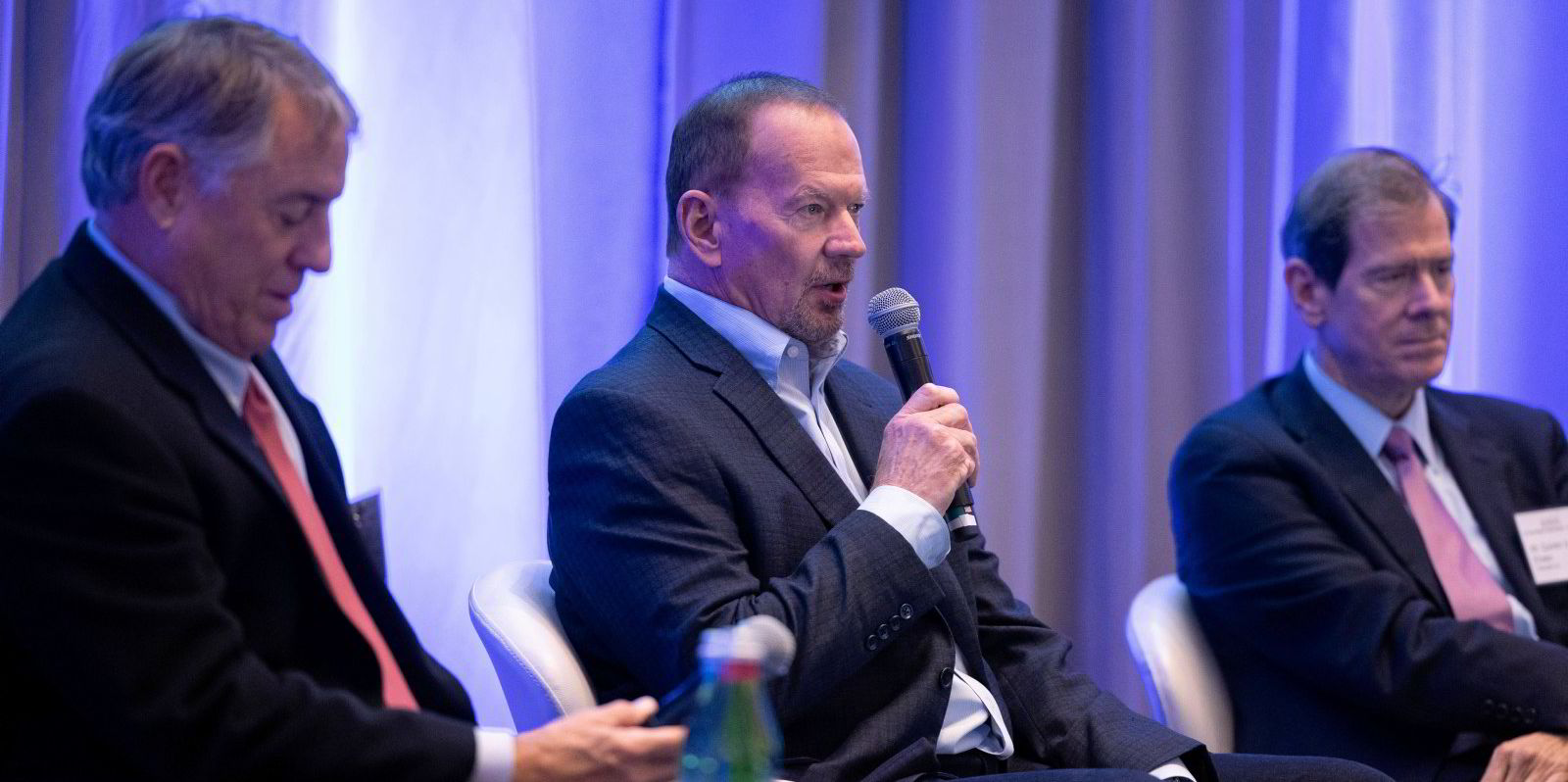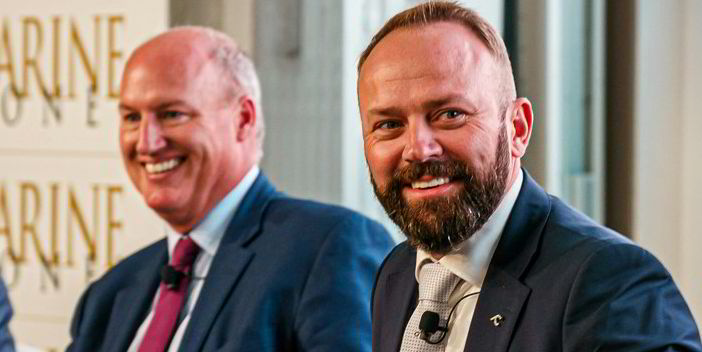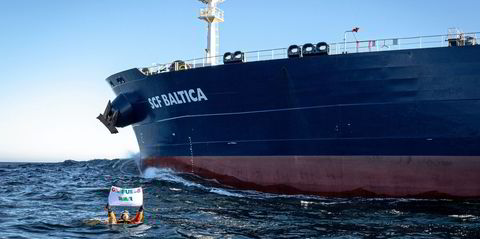It is not often that Streetwise ventures into the waters of the offshore energy industry — let alone those of the US-flag sector.
But a money conference in New Orleans last week provided a glimpse into a market that appears mostly stuck on its vessel finance options.
On the one hand is the wind farm industry, which may be the sector of the future but is still in its US infancy. It is reeling from recent project reversals as participants try to grapple with the dysfunction of economics that do not make much sense at present.
On the other is the offshore oil and gas industry, seen in some circles as home to dinosaurs and pariahs. But it is enjoying a market rebound now, delivering the best hire rates in years — if only that provided the financial underpinnings for the renewal of an ageing fleet, which it does not.
The two sides gave back-to-back state-of-the-sector appraisals last week at Marine Money’s annual finance forum in New Orleans.
While all the right things were said about current highlights and bright prospects, the overwhelming takeaway was a sense of frustration when it comes to sourcing money from maritime financiers.
“What keeps me up at night these days is the financing, and making sure there’s enough to meet target goals — right now there’s a big bottleneck” said Bradley Neuberth, managing partner of MidOcean Wind, a Connecticut-based company formed to supply vessels to offshore wind farms serving the US.
“Commercial lending for offshore wind is extremely tight at the moment. There are a lot of risks that have been well-publicised. Even before that, the US banks were already uncomfortable with offshore wind. And the international banks are not interested in Jones Act business.”
As Neuberth suggested, the recent publicity has not been good, but neither have the developments in the market.
Wind energy recently has suffered a series of major reversals around heavy cost increases, supply chain problems and issues with reliability of equipment.
Within several weeks this autumn, Denmark’s Orsted cancelled two projects off the coast of New Jersey, while developers in New England scrapped power contracts for three projects.
Orsted disclosed write-downs of $5.6bn, while a top BP official described the US market as “fundamentally broken”.
This is all despite strong support for the wind sector from the administration of US President Joe Biden.
But with another presidential election looming in 2024 and a likely rematch with Republican Donald Trump again pegged a tossup, there is further reason for financiers to worry about an about-face in approach.
The US has no national energy policy or strategy, and that sort of ambiguity is not something that gives bankers comfort.
MidOcean has partnered with Germany’s Bernhard Schulte Offshore to build offshore support vessels (OSVs) for the market.
The company is pursuing a September 2022 application with the US Maritime Administration’s Title XI programme for up to 10 crew transport vessels (CTVs) but the review is taking some time, Neuberth acknowledged.
“Title XI is a nice alternative,” Neuberth said. “It’s something we’ve utilised twice. The benefits are a longer repayment period, lower interest rates and a higher gearing level.”
The funding was made possible when the US declared wind support units “vessels of national interest” in 2022.
“We’re still in the process,” Neuberth said. “It’s taken a bit longer than expected. But MarAd is facing the same pressures as other lenders. The longest CTV charter available right now is five years. They’ve seen others step out of projects.”
A later panel featured the OSV owners, and this seemed a way to end the forum on a high note — “laissez le bon temps rouler,” as the New Orleans locals like to say.
Despite earnings flipping positive for companies such as New York-listed Tidewater in 2023 as the recovery continued from the market collapse between 2014 and 2017, executives’ enthusiasm seemed tempered.
“This industry has been through so much over the past eight years,” Tidewater chief executive Quintin Kneen said. “Demand is as high as it’s been in seven years. Hell, we might even get our cost of capital back for the next two years.”

Much of the restraint centred on the reality that even in a strong market, owners see little way to finance newbuildings to refresh a quickly ageing fleet.
Among the limiting factors:
- Banks still have fresh memories of getting burned in the market collapse, which plunged several owners into bankruptcy;
- Many financiers have a problem lending into the oil-gas sector for reasons related to environmental, social and corporate governance (ESG) pressures;
- Newbuilding costs continue to escalate;
- Customers in the energy sector are not willing to step up with the kind of long-term contracts that would support newbuilding prices, nor will they pay up for greener propulsion systems.
“Nobody’s earning enough money today to justify replacement of a vessel,” Kneen said.
Peter Laborde, managing member of Laborde Marine Management, said: “When you’re building a new vessel, you have to factor in that there’s going to be a downturn while you’re still trying to pay for that boat. Hence why lenders won’t lend to our sector. We just went through that.”
Bob Gwinn, president of Harvey Gulf International Marine, was more optimistic than Laborde that the financing standoff eventually will be broken as customers baulk at the advanced fleet age.
“An oil company will give us a big contract to phase them out,” Gwinn said. “For a $140m or $150m boat, you need a 10 or 15-year contract to bail those out. It will have to happen at some point, but it’s probably a few years away.”
For all the old-age, new-age dynamic between the two sectors, they are also linked, as OSV owners potentially can supply the wind crowd with their needed tonnage. It’s just not happening yet — at least not much — given the economics.
Hornbeck Offshore Services already has plans to convert one OSV into a service operation vessel (SOV) for the wind sector and says it has other candidates in its fleet.
Kneen said Tidewater already has “a couple” operating off the north-east US.
Harvey has checked out the market but has not found the right terms.
“They’ve told us, ‘quit quoting us US oil firm prices, we need wind-farm prices’,” Gwinn said. “But we’ll all have boats up there one of these days.”





